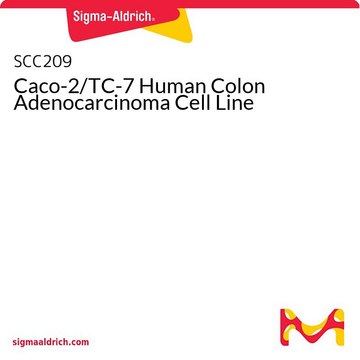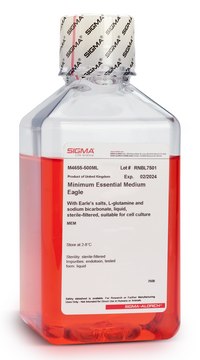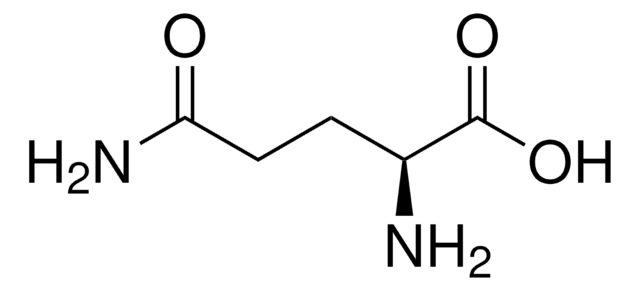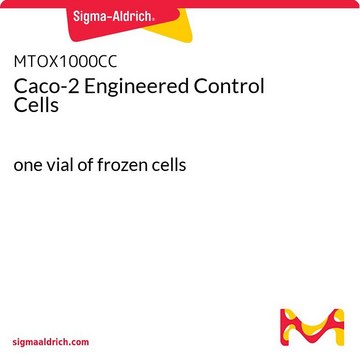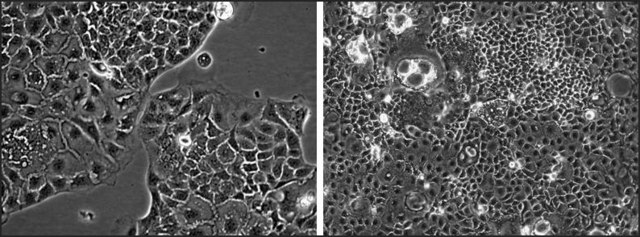推荐产品
产品名称
CACO-2, Caucasian colon adenocarcinoma
生物来源
human colon
质量水平
表单
liquid
生长模式
(Adherent)
核型
(Hypertetraploid, modal no. 96)
形态学
Epithelial
产品
Not specified
受体
Not specified
技术
cell culture | mammalian: suitable
相关疾病
cancer
运输
dry ice
储存温度
−196°C
细胞系来源
Human caucasian colon adenocarcinoma, intestinal permeability characteristics tested
细胞系描述
Isolated from a primary colonic tumour in a 72-year-old Caucasian male using the explant culture technique. Forms moderately well differentiated adenocarcinomas consistent with colonic primary grade II, in nude mice. This CACO-2 catalogue number has undergone testing for intestinal permeability: Dome, microvilli and tight junction formation and transport functionality tested and confirmed present at ECACC.
应用
CACO-2 has been used in the cytotoxicity studies with high pressure-assisted extraction (HPE) fraction of nettle leaf extracts.
CACO-2 may be used as a cell model to study:
CACO-2 may be used as a cell model to study:
- in vitro permeability assay with various biopharmaceuticals
- in iron uptake and absorption studies
- in the cytotoxicity assay with surfactants and transporter inhibitors
- in liposome formulated drug uptake and cytotoxicity studies
生化/生理作用
Caco-2 (Cancer coli-2) is derived from colorectal adenocarcinoma and grows as an adherent monolayer of epithelial cells. Caco-2 cell line is a widely used intestinal epithelium model and has unique spontaneous differentiation and confluence property. It actively transports vitamins, hormones, amino acids and sugars. Caco-2 expresses various enzymes, ionic and non-ionic transporters similar to normal human epithelia. Caco-2 cell line models grow on filter support. They have simplicity and reproducibility and provide reliable information. Since Caco-2 mimics the intestinal epithelium, it is the preferred cell model for cytotoxic studies, food and drug transport studies.
DNA图谱分析
STR-PCR Data:
Amelogenin: X
CSF1PO: 11
D13S317: 11,13,14
D16S539: 12,13
D5S818: 12,13
D7S820: 11,12
THO1: 6
TPOX: 9,11
vWA: 16,18
Amelogenin: X
CSF1PO: 11
D13S317: 11,13,14
D16S539: 12,13
D5S818: 12,13
D7S820: 11,12
THO1: 6
TPOX: 9,11
vWA: 16,18
培养基
EMEM (EBSS) + 2mM Glutamine + 1% Non Essential Amino Acids (NEAA) + 10% Foetal Bovine Serum FBS / FCS.
传代培养常规
Split sub-confluent cultures (70-80%) 1:3 to 1:6 i.e. seeding at 2-4x10,000 cells/cm² using 0.25% trypsin or trypsin/EDTA; 5% CO2; 37°C. NB: During routine subculture the cells should always be subcultured before they achieve confluence. Cells may show the appearance of circular vacuoles in the cytoplasm. These may increase in frequency as the culture density increases to confluence. To reduce their frequency, media change confluent cultures after 2-3 days if not subcultured. Cells can clump if not separated into a single cell suspension when split.
其他说明
Additional freight & handling charges may be applicable for Asia-Pacific shipments. Please check with your local Customer Service representative for more information.
Cultures from HPA Culture Collections and supplied by Sigma are for research purposes only. Enquiries regarding the commercial use of a cell line are referred to the depositor of the cell line. Some cell lines have additional special release conditions such as the requirement for a material transfer agreement to be completed by the potential recipient prior to the supply of the cell line. Please view the Terms & Conditions of Supply for more information.
NaviCyte Scientific holds the exclusive commercial distribution rights to the CACO-2 cell line deposited by the Memorial Sloan-Kettering Cancer Center. Note: All uses of Catalogue Numbers 86010202 and 09042001, other than for research by a non-commercial or academic entity, require a license and use authorization from NaviCyte Scientific under its exclusive arrangement with Memorial Sloan-Kettering Cancer Center. For information on the licensing terms, please contact NaviCyte Scientific via contact@navicyte-scientific.com or (+1) 973-868-6100.
免责声明
RESEARCH USE ONLY. This product is regulated in France when intended to be used for scientific purposes, including for import and export activities (Article L 1211-1 paragraph 2 of the Public Health Code). The purchaser (i.e. enduser) is required to obtain an import authorization from the France Ministry of Research referred in the Article L1245-5-1 II. of Public Health Code. By ordering this product, you are confirming that you have obtained the proper import authorization.
储存分类代码
10 - Combustible liquids
WGK
WGK 3
闪点(°F)
188.6 °F - closed cup
闪点(°C)
87 °C - closed cup
法规信息
监管及禁止进口产品
Biopharmaceutical classification of desloratadine-not all drugs are classified the easy way
Berginc K, et al.
Acta pharmaceutica (Zagreb, Croatia), 70, 131-144 (2020)
M Lautenschläger et al.
Phytomedicine : international journal of phytotherapy and phytopharmacology, 22(1), 36-44 (2015-02-01)
Extracts of saffron (Crocus sativus L.) have traditionally been used against depressions. Recent preclinical and clinical investigations have rationalized this traditional use. Trans-crocetin, a saffron metabolite originating from the crocin apocarotenoids, has been shown to exert strong NMDA receptor affinity
High-throughput screening of excipients with a biological effect: a kinetic study on the effects of surfactants on efflux-mediated transport
Pollard J, et al.
The Journal of Pharmacy and Pharmacology, 71, 889-897 (2019)
Giuseppe Esposito et al.
Frontiers in pharmacology, 7, 120-120 (2016-06-01)
Clostridium difficile infections (CDIs) caused by Clostridium difficile toxin A (TcdA) lead to severe ulceration, inflammation and bleeding of the colon, and are difficult to treat. The study aimed to evaluate the effect of rifaximin on TcdA-induced apoptosis in intestinal
Eszter Róka et al.
Molecules (Basel, Switzerland), 20(11), 20269-20285 (2015-11-17)
Cyclodextrins, even the 6-membered α-cyclodextrin, are approved in the various pharmacopoeias as pharmaceutical excipients for solubilizing and stabilizing drugs as well as for controlling drug release. Recently α-cyclodextrin has also been marketed as health food with beneficial effects on blood
我们的科学家团队拥有各种研究领域经验,包括生命科学、材料科学、化学合成、色谱、分析及许多其他领域.
联系技术服务部门
